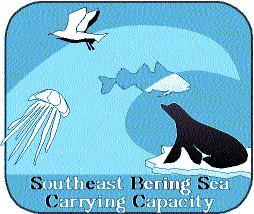Using output from the regional model of the Southeast Bering Sea
and the Virtual Reality Markup Language we have generated a virtual
ocean, containing model bathymetry with sea surface height and temperature
for May 15, 1997. The surface representing the sea floor is colored by
the depth (red is shallow, blue is deeper). Hovering above it is a surface
representing the low-pass-filtered sea surface height (no tides) colored
by the temperature at 10m depth (blue is cold, red is hot). The spiky protrusions
out of the sea surface are islands (the Aleutian chain along the southern
edge, the Pribolofs towards the north). Most web browsers now come equipped
with a VRML viewer which allows you to fly around these surfaces; if you
need a viewer try here. If
you can't view the virtual ocean in this way, here's a simple
screen snapshot to give you an idea of how it looks. Note that the
bathymetry used in this world is smoothed relative to the real thing and
spans 50m-1000m depths (it is in fact the bathymetry used by the regional
model at present). Flying around these surfaces gives you a nice sense
of the submarine canyons, and the large-to-small scale eddies in the sea
surface. The axes represent northeast(red), northwest(green) and downward
(blue) directions. When you first enter this world you will be looking
to the southeast; Pribolof canyon is the major bathymetric feature directly
ahead.
Development work for Virtual Reality at PMEL is funded by the NOAA/HPCC
program. Thanks to Chris Moore and Nancy Soriede for their guidance on
using VRML.
 US
Dept of Commerce / NOAA / OAR
/ ERL / PMEL
US
Dept of Commerce / NOAA / OAR
/ ERL / PMEL US
Dept of Commerce / NOAA / OAR
/ ERL / PMEL
US
Dept of Commerce / NOAA / OAR
/ ERL / PMEL

